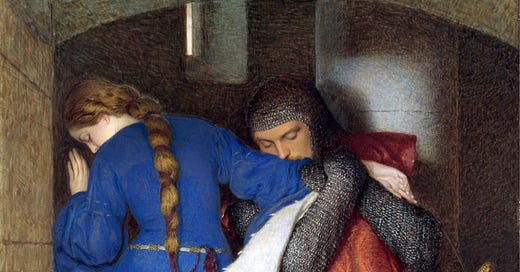Provenance:
Frederic William Burton painted The Meeting on the Turret Stairs in 1864, not in oil, but in watercolor. The painting is meticulously layered, jewel-toned, yet restrained. Burton was an Irish painter trained in the traditions of the Pre-Raphaelites, though he never fully belonged to their circle. He preferred solitude. He never married. He left behind few traces of a personal life, but this painting feels like a confession.
It depicts a single moment from a tragic medieval Danish ballad: the secret lovers, Hellelil and Hildebrand, caught just before the final unraveling. Her family has condemned him to death. They meet one last time. She doesn’t touch him, not really. He doesn’t turn around. Their bodies say what their mouths can’t. The original hangs in the National Gallery of Ireland- protected, barely public, shown only at short intervals, like something too delicate to be seen too often.
Burton was Director of the National Gallery in London for two decades, but this is the piece that outlives his curatorship. It was never a commission. He painted it for himself.
Why This Painting Moved Me to Write:
I invoked Coltrane in the prose that follows not just for atmosphere, but because he, like Burton, mastered the language of restraint. Because he knew how to leave space in a song so wide you could live inside it. Because his refusals said more than most declarations ever could. Because absence, is erotic. And silence, a kind of spiritual weather.
Because it’s all about what doesn’t happen. Because it says more in a refusal than most art does in an explosion. Because I’m interested in that kind of heat; the kind you carry in your chest, the kind of burn you don’t let out. It is the sacred energy in restraint. In longing that never becomes possession.
Because Burton, a man who lived his life away from intimacy, still gave us this- and to show he understood it. Not the performance of love, but the ache of almost. The ceremony of nearly.
This painting holds a kind of erotic intelligence that doesn’t sell itself. It doesn’t seduce you with climax. Instead, it withholds- and in that withholding, it makes you feel more. That’s why I wrote the prose. To speak back to that silence. A kind of silence all too familiar to me lately. I wrote the prose to let the bodies say what they were never allowed to. To sit in that suspended moment where want and discipline blur- and tell the truth about how desire really works, at least for me.
The Meeting on the Turret Stairs
You don’t look-
You feel them instead,
that impossible closeness.
The almost. The ache of what won’t arrive.
Burton gives you no kiss.
No consummation.
Just the tension humming between a knight and a girl,
caught in the fever of restraint.
That Holy Ghost of want.
The divine silence between inhale and don’t.
Hildebrand-
his back a drawn bow,
so tight you wonder if he ever learned to exhale.
He’s bracing for the future they won’t have,
still sculpted in armor and ache.
He knows: movement kills myth.
If he breathes, it all dissolves.
He’s choking on prophecy.
And Hellelil-
girl of ghosts and hovers,
her hand says what her mouth never can.
Hovering like a benediction over his chest,
over his ruin.
Her hand is a sermon on touch without touching.
Hovering like a blue note in a room full of minor chords.
She knows.
To break the silence is to betray it.
To kiss him is to kill the only real thing they have:
the heat between what never happens.
This is not about love.
This is not about story.
This is the jazz of restraint.
The eroticism of denial.
The sacred gospel of almost.
The slow ruin that refuses to erupt,
and so it burns forever.
Ireland calls it their favorite painting.
We call it muscle memory.
We call it that moment after Naima fades-
after Coltrane leaves you hollow,
and the melody hangs like a dress still warm from the skin that wore it.
We understand.
We’ve lived it.
That room where you wanted and didn’t move.
Where you hovered like her.
Where you held your breath like him.
Burton paints it like a spell:
Hellelil and Hildebrand are a requiem,
a medieval elegy for the unfinished.
Her brothers kill him.
But the real death is here-
in the stillness before goodbye.
In the unkissed space.
It’s all we have sometimes.
The never that lingers louder than the ever.
The silence that seduces louder than any song.
We keep returning,
to them, to this-
because we know:
desire lives best in the pause.
In the breath before the break.
In the heat before the fire.
In the moment you almost said it.
In the painting that never lets you forget what not touching can do-
like the lush, unresolved harmonic structure of Naima,
where suspended chords float instead of settle,
holding longing in balance-
in that iconic opening,
the gentle, hovering interval between E♭ and A♭,
a sound caught between hope and hesitation,
the very space where desire lingers-
never quite landing,
yet, it’s right there.




